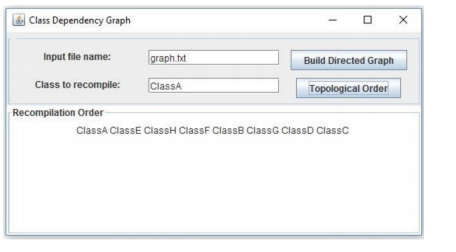Question
The fourth programming project involves designing, writing and testing a program that behaves like the Java command line compiler. Whenever we request that the Java
The fourth programming project involves designing, writing and testing a program that behaves like the Java command line compiler. Whenever we request that the Java compiler recompile a particular class, it not only recompiles that class but every other class that depends upon it, directly or indirectly, and in a particular order. To make the determination about which classes need recompilation, the Java compiler maintains a directed graph of class dependencies. Any relationship in a UML class diagram of a Java program such as inheritance relationships, composition relationships and aggregations relationships indicate a class dependency. The main class P4GUI should create the Swing based GUI shown below:

The GUI must be generated by code that you write. You may not use a drag-and-drop GUI generator. Pressing the Build Directed Graph button should cause the specified input file that contains the class dependency information to be read in and the directed graph represented by those dependencies to be built. The input file should be generated by the students using a simple text editor such as Notepad. The input file associated with the above example is shown below:
ClassA ClassC ClassE
ClassB ClassD ClassG
ClassE ClassB ClassF ClassH
ClassI ClassC
Each line of this file specifies classes that have other classes that depend upon them. The first line, for example, indicates that ClassA has two classes that depend upon it, ClassC and ClassE. In the context of recompilation, it means that when ClassA is recompiled, ClassC and ClassE must be recompiled as well. Using graph terminology, the first name on each line is the name of a vertex and the remaining are its associated adjacency list of dependent classes. Classes that have no dependent classes need not appear at the beginning of a separate line. Notice, for example, that ClassC is not the first name on any line of the file. After pressing the Build Directed Graph button, one of following two messages should be generated depending upon whether the specified file name could be opened:

Once the graph has been built, the name of a class to be recompiled can be specified and the Topological Order button can be pressed. Provided a valid class name has been supplied, a topological order algorithm should be executed that will generate (in the text area at the bottom of the GUI window) the list of classes in the order they are to be recompiled. The correct recompilation order is any topological order of the subgraph that emanates from the specified vertex. An invalid class name should generate an exception and an appropriate error message will be displayed in a JOptionPane. If the graph contains a cycle among the Java classes, an exception will be thrown and a message will be displayed in a JOptionPane indicating that a cycle has been detected. Note. In the real compiling processes, when circular dependencies exist in Java programs, the compiler must make two passes over all the classes in the cycle. For this program, it will be sufficient to display a message indicating that a cycle has been detected. In addition to the main class that defines the GUI, a second class is needed to define the directed graph. It should be a generic class allowing for a generic type of its vertices. In this application the type of the vertices will be String. For better processing purposes, integer values will be used to represent the vertices instead of Strings. The graph should be represented as an array list of vertices (as integer values) that contain a linked list of their associated adjacency lists. The adjacency lists should be lists of integers that represent the index rather than vertex name itself. A hash map should be used to associate vertex names with their index in the list of vertices. For the input file shown above the array list of linked lists of integers would be the following:
0 [1, 2]
1 [] 2 [3, 6, 7]
3 [4, 5]
4 []
5 []
6 []
7 []
8 [1]
Storing the vertex indices rather than the names simplifies the topological order algorithm. The hash map would associate index 0 with ClassA, index 1 with ClassC, index 2 with ClassE and so on. The directed graph class should define methods for initializing the graph each time a new file is read in, for adding a vertex to the graph, for adding an edge to the graph and for generating a topological order given a starting index. Other classes / methods could be also defined to achieve the program requirements and/or to better structuring the code. Finally, custom checked exception classes should be defined for the cases where a cycle occurs and when an invalid class name is specified. Your program should compile without errors.
Class Dependency Graph Input file name:graph.tt Build Directed Graph Class to recompile: ClassA Topological Order Recompilation Order ClassA ClassE ClassH ClassF ClassB ClassG ClassD ClassC Class Dependency Graph Input file name:graph.tt Build Directed Graph Class to recompile: ClassA Topological Order Recompilation Order ClassA ClassE ClassH ClassF ClassB ClassG ClassD ClassCStep by Step Solution
There are 3 Steps involved in it
Step: 1

Get Instant Access to Expert-Tailored Solutions
See step-by-step solutions with expert insights and AI powered tools for academic success
Step: 2

Step: 3

Ace Your Homework with AI
Get the answers you need in no time with our AI-driven, step-by-step assistance
Get Started


